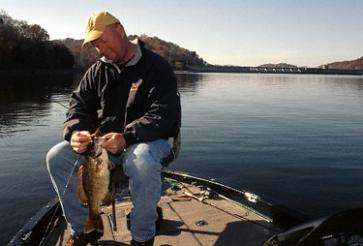
A question I get asked a lot when I'm traveling around the country doing seminars is "What's the most common mistake smallmouth bass anglers make when they're fishing a jig?" It's a really good question, and I've had a chance to think about it for several years now, so my answer has changed a little over time.
I used to tell people that the biggest mistake was that they didn't fish the jig often enough or that they didn't fish it slowly enough. Both of those answers are true, by the way.
But now I think the biggest mistake most anglers make when fishing a jig is that they don't keep their rod tip low enough when they fish it. Instead they keep the rod tip up at 11 or 12 o'clock, which is a great position for detecting strikes, but a poor one for setting the hook.
If you watch your line carefully, like I do, you'll soon realize that you can see more strikes than you ever feel. And since that's true, you'll do yourself a big favor by keeping your rod low during a jig retrieve — from about 9 to 10 o'clock.
You might be able to get away with a high rod angle when largemouth fishing or even when the smallmouth are really tearing it up, but on slow days or when you need to turn every strike into a catch, keeping your rod tip low will pay off for you with more bass.
The reason is simple. When your rod tip is low — nearly parallel to the water — you're in a better position to set the hook, and you need to be able to do that very, very fast. Smallmouth are curious creatures, but they don't have hands. The only way they can check something out is by picking it up in their mouths. When they're curious and not really feeding — which I think is a big majority of the time — you don't have as long to set the hook as when they're eating heavily and sucking that lure all the way to the backs of their mouths.
By keeping your rod low, your eyes on the line and by having a hair trigger hook set, you're going to catch a lot more smallmouth.
And remember to set the hook just as soon as you feel something different, something you can't recognize. The strike isn't always a solid thump or even a mushy feeling. Sometimes it's the complete loss of feeling because a fish has picked up your bait and is moving toward you with it. Other times it's completely different from any of those. Watch your line closely, and set the hook just as soon as you see it move or feel something different.
Almost as important when you're setting the hook on a good smallmouth is to get your hand on the reel right away (better yet, never take it off) and get cranking on that fish to keep the line tight and the bass moving toward you. Slack line is your enemy, and you need to keep that fish coming after the hook set.
Finally, don't wait when you have a strike! It's a guarantee that the bass doesn't have your lure in its hands!





